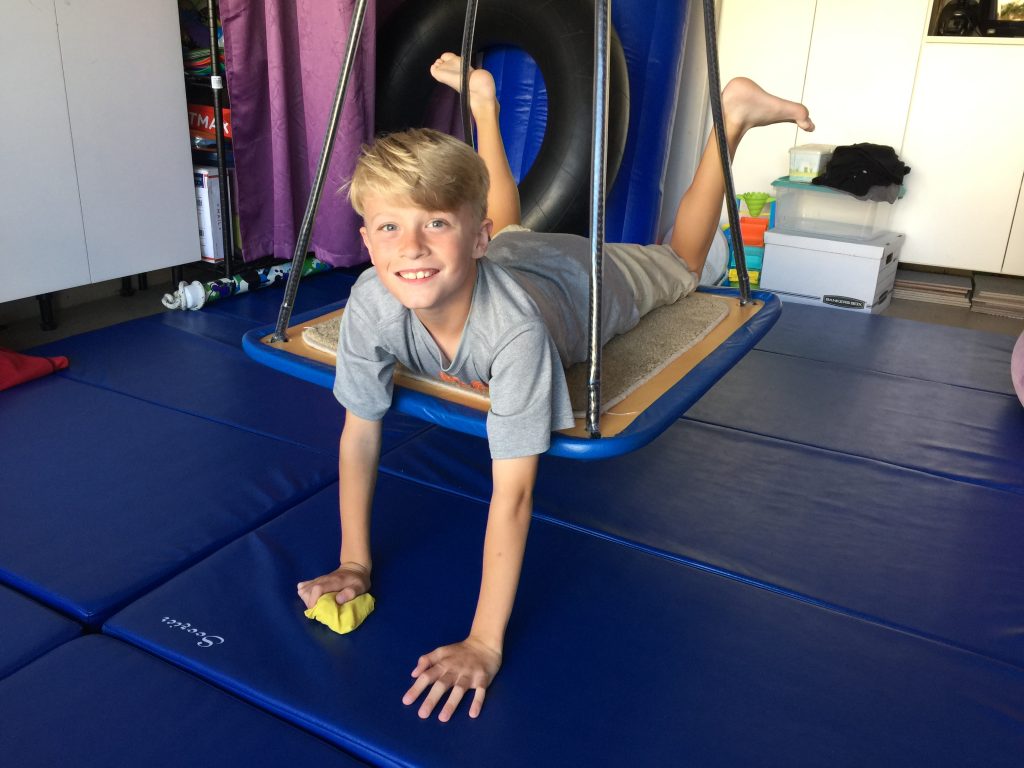Sensory Integration (Sensory Processing Disorder) at WriteSteps Pediatric Occupational Therapy

At WriteSteps, Danielle has received advanced certification, through USC, in the evaluation and treatment of sensory integration disorders. Danielle believes that in order to understand the mechanics and specific treatment protocols for effective treatment in SI, this program is a necessity for those treating SI. Danielle’s clinic is specialized for children with sensory integration difficulties. She also incorporates a variety of vestibular and tactile opportunities, using suspending swings when necessary, to help children with sensory processing disorders to help improve areas of difficulty that include: tactile or movement sensitivity, self-regulation, motor skills and dyspraxia, and fine motor skills, including handwriting. Danielle provides children with sensory integration processing difficulties the opportunity to explore their environment and seek a variety of tools to help with self-regulation.
Danielle also believes that parents, teachers, and the child can be educated on appropriate sensory strategies in order in improve the everyday demands of the sensory world around them. Danielle applies many of her principles based on the programs utilized by a well known and respected occupational therapist, Diana Henry. Diana has written many books and given many lectures on how to implement sensory strategies into everyday life, whether it be in the classroom or at home. Danielle educates the family on tools to help children become more sensory regulated using an economical perspective. Many things that can help children focus are easily found in the their home environment or can be ordered for a minimal price. Danielle also provides individual consultations to families and schools so they may be able to learn sensory strategies to help their child.
Danielle is also trained in:
- Specially certified Sensory Integration and Praxis Test (SIPT)
- The Wilbarger Protocol
- SOS Approach to Feeding Disorders which helps children with medical disorders as well as picky eaters
- ALERT Program
- Brain Gym
- Sesnory Tools for Teens, Parents, and Teachers
- Stick Kids Software
What is Sensory Integration Dysfunction (Sensory Processing Disorder)?
The following description is taken from www.spdfounation.net, a great site to help explain in more detail about sensory integration and it provides a variety of excellent resources. This description is helpful for parents because it takes out a lot of the technicalities of sensory integration and makes it easier to understand.
“Sensory Processing Disorder (SPD, formerly known as “Sensory Integration Dysfunction”) is a condition that exists when sensory signals don’t get organized into appropriate responses. Pioneering occupational therapist and neuroscientist A. Jean Ayres, PhD, likened SPD to a neurological “traffic jam” that prevents certain parts of the brain from receiving the information needed to interpret sensory information correctly. A person with SPD finds it difficult to process and act upon information received through the senses, which creates challenges in performing countless everyday tasks. Motor clumsiness, behavioral problems, anxiety, depression, school failure, and other impacts may result if the disorder is not treated effectively.”
Some common signs of a child who has difficulty with sensory integration (SPD) are listed below and were compiled by the Sensory Processing Disorder Foundation. It is important to note that this is not a diagnostic checklist and rather a summary of some characteristics a child with sensory processing.
Pre-School Checklist:
- My child is overly sensitive to stimulation, overreacts to or does not like touch, noise, smells, etc.
- My child is unaware of being touched/bumped unless done with extreme force/intensity.
- My child has difficulty learning and/or avoids performing fine motor tasks such as using crayons and fasteners on clothing.
- My child seems unsure how to move his/her body in space, is clumsy and awkward.
- My child has difficulty learning new motor tasks.
- My child is in constant motion.
- My child gets in everyone else’s space and/or touches everything around him.
- My child has difficulty making friends (overly aggressive or passive/ withdrawn).
- My child is intense, demanding or hard to calm and has difficulty with transitions.
- My child has sudden mood changes and temper tantrums that are unexpected.
- My child seems weak, slumps when sitting/standing; prefers sedentary activities.
- It is hard to understand my child’s speech.
- My child does not seem to understand verbal instructions.
School Age:
- My child is overly sensitive to stimulation, overreacts to or does not like touch, noise, smells, etc.
- My child is easily distracted in the classroom, often out of his/her seat, fidgety.
- My child is easily overwhelmed at the playground, during recess and in class.
- My child is slow to perform tasks.
- My child has difficulty performing or avoids fine motor tasks such as handwriting.
- My child appears clumsy and stumbles often, slouches in chair.
- My child craves rough housing, tackling/wrestling games.
- My child is slow to learn new activities.
- My child is in constant motion.
- My child has difficulty learning new motor tasks and prefers sedentary activities.
- My child has difficulty making friends (overly aggressive or passive/ withdrawn).
- My child ïgets stuck’ on tasks and has difficulty changing to another task.
- My child confuses similar sounding words, misinterprets questions or requests.
- My child has difficulty reading, especially aloud.
- My child stumbles over words; speech lacks fluency, and rhythm is hesitant.